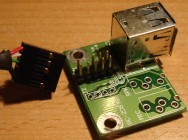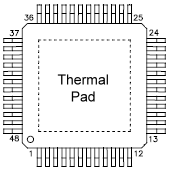Definitions of Technical Terms
"A"
"B"
"C",
"D",
"E",
"F",
"G",
"H",
"I",
"J",
"K",
"L",
"M",
"N",
"O",
"P",
"Q",
"R",
"S",
"T",
"U",
"V",
"W",
"X",
"Y",
"Z"
"T" to "Ter", "Ter"
"Thermb" to "Top",
"Tor" to "Transf",
"Trans" to "Tre",
"Triac" to "Tub",
"Tun" to "Tz"
Test Equipment. A general term applied to devices used to test electrical and electronic circuits. [Manufacturers of Test Equipment]
Test Point. Locations in equipment or devices that are accessible to the technician's test probes where operating voltages or signals can be monitored. In this example, a Header, but a test point could just be a via or pad on the Printed Wiring Board [PWB]. Right Angle Test-Point in the side-bar. |
 Test Points |
Tetrode Tube. A four-electrode electron tube containing a plate, a cathode, a control grid, and a screen grid. Also refer to Vacuum Tube Classifications or the Vacuum Tube definition. |
 Tetrode |
|
T Flip Flop. A style of flip flop that toggles on a clock edge, with the input high and does not change when the T input is low. A T flip flop can be produced by using a JK flip flop. So leaving the 'T' input high causes the output to toggle or change state with each clock pulse [high to low to high and so on]. |
 T Flip Flop |
Thermal Adhesive. A conductive material that also acts as an adhesive, which could include an epoxy material or conductive tape. Also see Companies producing Thermal Adhesive.
Thermal Breakdown. See Thermal Runaway. Could be used to describe the point that the semiconductor is destroyed by the effects of thermal runaway.
Thermal Compound. [Thermal Grease] A compound or paste with good thermal conductivity properties applied between two surfaces to increase the thermal conductivity between the surfaces by filling in any air voids on the surface. Thermal Grease increases thermal conductivity by filling in any voids, scratches on imperfections on either of the surfaces allowing the entire surface to mate.
Thermal Equilibrium. Thermal equilibrium is reached when doubling the test time interval does not produce
a change, due to thermal effects, in the parameter being measured.
Thermal Impedance. The resistance to heat transfer.
Thermal Inertia. The capacity of a soldering iron to generate and maintain a satisfactory soldering temperature while giving up heat to the material being soldered.
Thermal-Magnetic Trip Element. A single circuit breaker trip element that combines the action of a thermal and a magnetic trip element.
Thermal Noise. The white noise generated by a passive component. The noise generated by thermal agitation of electrons in a conductor. A type of electromagnetic noise produced in electronic circuitry whose power is proportional to temperature.
Thermal Pad. A thermally conductive area on an IC that is connected to the semiconductor die to enhance heat transfer away from the semiconductor. The Thermal Pad may also be electrically connected to the die. Bonding a thermal plate or heat sink to the pad may also enhance the heat transfer. Refer to the graphic to the right.
Thermal Resistance. A figure of merit for heat transfer [temperature drop divided by power dissipation] between two points in a conductive system.
(T1 - T2)/Pd [in C/W]. The temperature rise, per unit power dissipation, of a junction
above the temperature of a stated external reference point under conditions of thermal equilibrium. BJT Thermal Resistance data [transistor graphs].
Thermal Runaway. A conduction that exists when heat causes more electron-hole pairs to be
generated, which, in turn, causes more heat and which may eventually cause component destruction [in diodes and transistors]. Several semiconductor characteristics are a function of temperature, power loses increase with increasing temperature causing more and more heat to build within the device until the junction temperature is exceeded.
Thermal Shock. Thermal shock is the effect of heat or cold applied at such a rate that non-uniform thermal expansion or contraction occur within a given material or combination of materials. In connectors, the effect can cause inserts and other insulation materials to pull away from metal parts. A sudden change in the temperature surrounding a component.
Thermal Trip Element. A circuit breaker trip element that uses the increased bending of a
bimetallic strip caused by increased current to open a circuit. Also see Companies producing Circuit Breakers.
Thermal Via. A via in the Printed Wiring Board [PWB] to effectively transfer heat
from the top copper layer of the Printed Circuit Board [PCB] to the inner or bottom copper layers. The thermal vias should make their connection to the internal ground plane with a complete connection
around the entire circumference of the plated through hole. Do not use a thermal relief web or spoke connection which impedes the conduction path into the inner copper layer. Also refer to the definition of Via, or dictionary of PWB Terms.









